Family : Caricaceae

Text © Pietro Puccio

English translation by Mario Beltramini
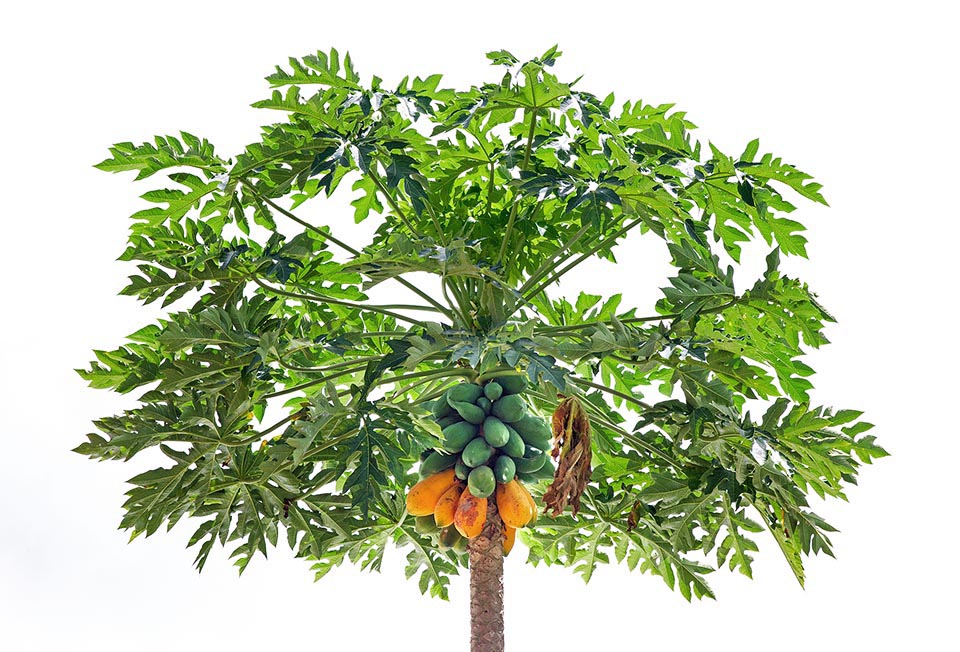
The Carica papaya, semi-herbaceous plant, may be 6 m tall, with 30-60 cm broad leaves © Giuseppe Mazza
The exact area of origin is not known, it is thought to extend from southern Mexico to Central America; the first historical news report it as present by the beginning of 1500 in the Caribbean coasts of Central America and in Hispaniola; as a matter of fact, it is mentioned by the Spanish historian and naturalist Gonzalo Fernández de Oviedo y Valdés (1478-1557), and already by the mid of the same century its seeds were carried by the Spaniards to the Philippines and from here to Malaysia and India. By the beginning of the following century, its cultivation was already spread to tropical southern America and to all the Caribbean.
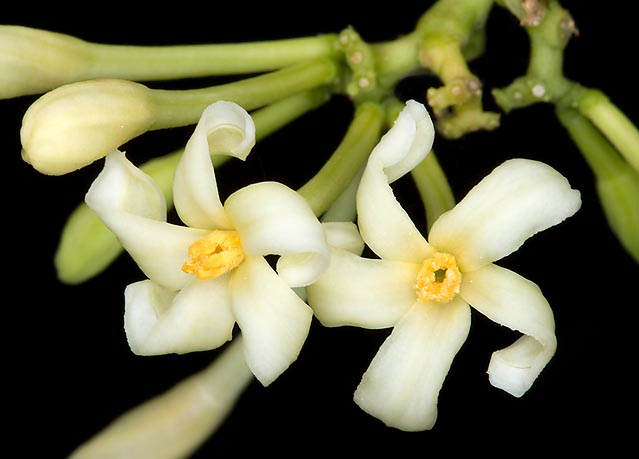
Male flowers. Usually dioecious plant, but varieties with hermaphrodite flowers exist in cultivation © Mazza
Common names: “papaya”, “pawpaw” (Australia) (English); “papaia”, “papaya” (Italian); “papayer” (French); “ababaia”, “fruto do mamoeiro”, “mamão”, “mamãodo-Amazonas”, “mamãozinho”, “papaeira” (Portuguese); “fruta bomba”, “lechosa”, “lechoso”, “lechoza” (Venezuela), “mamón”, “melón de árbol”, “melón zapote” (Mexico), “papayero”, “papayo” (Spanish); “Melonenbaum”, “Papajabaum”, “Papajapflanze” (German).
The Carica papaya L. (1753) is a tree, even if, more precisely, it should be defined as a semi-herbaceous plant, usually with a single erect stem, not ramified, up to 6 m tall and with a diameter of even 20-30 cm, with a milky sap and green bark, tending to the brown grey with the age, on which persist evident the foliar scars. The leaves, on a hollow petiole, long up to 0,8-1 m, spirally placed in the terminal part of the stem, have a pinnatifid lamina, 30 to 60 cm broad, deeply divided into 5-9 lanceolate or ovate lobes with entire margin or, in turn, subdivided in lanceolate or ovate lobes.
The plant is usually dioecious (each individual carries only either male or female flowers), rarely monoecious, but they have selected, in cultivation, several varieties with hermaphrodite flowers.
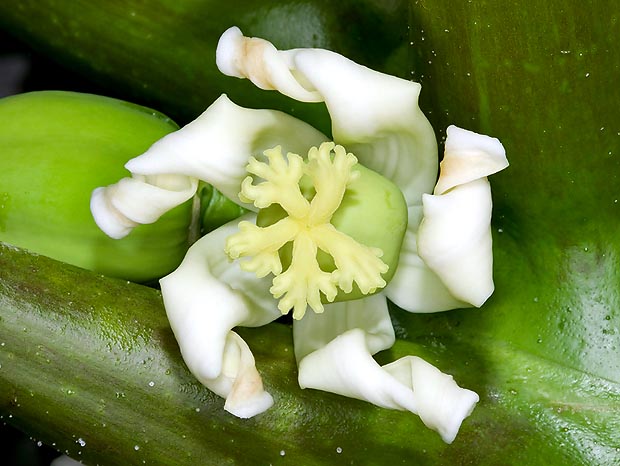
Fecundated female flower with showy stigma. All papaya flowers have 5 petals © Giuseppe Mazza
The hermaphrodite, in the monoecious varieties, have a 2-2,5 cm long coralline tube, a 5 oblong lobes corolla, about 2,6 cm long and 0,8 cm broad, 5 or 10 stamina and ovary.
Sometimes, male plants produce hermaphrodite flowers in the terminal part of the inflorescence, which however, produce small and elongated fruits. It may also happen that some varieties produce alternatively short male inflorescences and female flowers, depending on the seasonal trend. At last, owing to a damage or the breakage of the apex, plants with male or hermaphrodite flowers may change of sex, thus producing female flowers only.
The fruits, which in the Tropics are produced all the year round, are sub-globose or ovoid-cylindrical, 10-40 cm long with a diameter of 10-20 cm, yellow or orange-yellow when ripe, with yellow, orange or reddish juicy pulp, containing in a central cavity several black seeds, about 0,5 cm long, surrounded by a gelatinous membrane (aril).
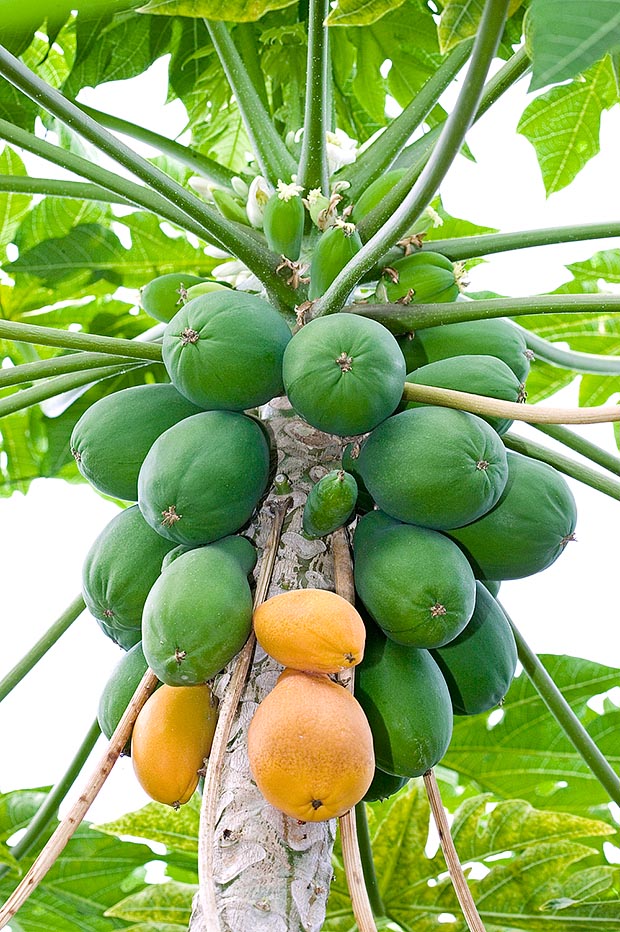
Carica papaya 'Maradol roja'. The fruits are rich in calcium, phosphorus, iron, potassium and vitamins A, B, C © Giuseppe Mazza
It usually reproduces by seed, which is t be cleaned from the gelatinous substance covering it, as this contains anti-sprouting, settled directly in its place or in containers in warm and luminous location; in order to avoid the frequent mortality for rottenness in the young small plants, it is wise to treat preventively the seeds with a fungicide and utilize, when seeding out from the soil, sterilized substrata.
The seeds germinate in 2-3 weeks, when in the Tropics, the first ripe fruits can be gotten after one year, a year and a half, and from that moment the production will continue relentlessly. If we wish to be sure to reproduce the variety we shall make use of the air layer or the herbaceous cutting in summer.
The papaya is one of the most popular tropical fruits, rich in calcium, phosphorus, iron, potassium and vitamins A, B and C, consumed well ripe, as it is or as juice, preserve and jelly.
It is a plant essentially tropical, it grows and fructifies well and abundantly in the areas where the temperatures keep between the 20 and the 30 °C; values around the 0 °C, even for an extremely short time, cause damage to the plant, prolonged periods with temperatures of just some degrees over 0 °C may be fatal. It prefers porous soils, rich in organic substance, neutral or sub-acid, abundantly watered during the dry periods, but well drained, as the plant does not bear stagnating water, which, if prolonged, may be lethal. The papaya plants are unfortunately subject to the attacks of several parasites, such as the “papaya fruit-fly” (Toxotrypana curvicauda) and the “papaya web-worm” (Homolapalpia dalera), to viral and fungal diseases, such as the anthracnose (Colletotrichum gloeosporioides) and powdery mildew (Oidium caricae), which cause serious damages to the cultivations.
The papaya is cultivated not only for its fruits, but also, and widely, for getting its latex which contains proteolytic enzymes, in particular, papain and chymopapain which have several utilizations. The latex is mostly obtained from the unripe fruits (peel and pulp), but also from other parts of the plant. The production of papain reaches its maximum in the one year old plants and then lessens considerably during the following years. The papain is utilized in the pharmaceutical industry for medicines with intestinal anti-parasite action; digestive, as it facilitates the absorption of the proteins, and anti-inflammatory.
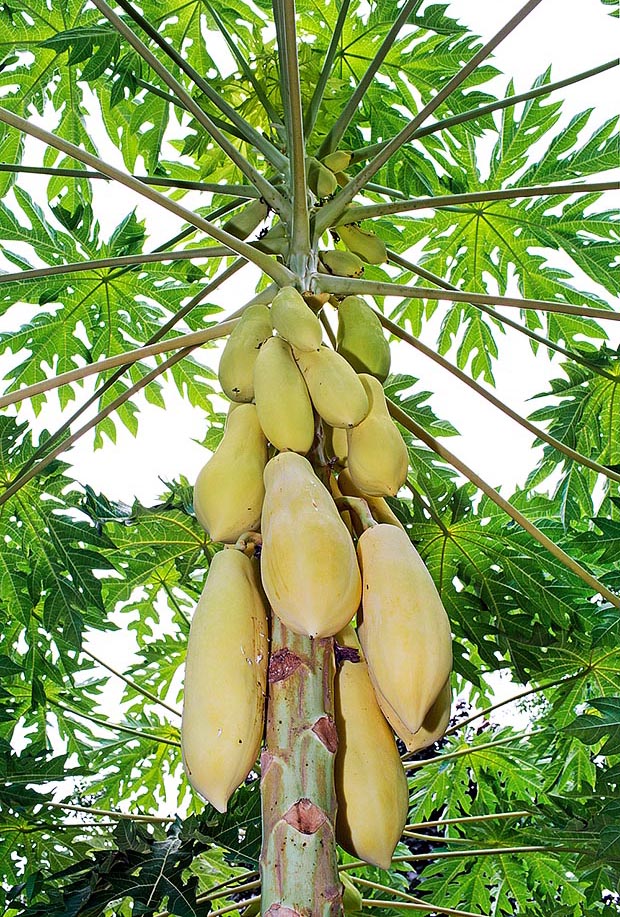
Numerous varieties exist with fruits of 0,5-1 kg and even more, up to exceptionally, 9 kg © Giuseppe Mazza
It must be kept present, in any case, that the papain may cause allergic reactions in particularly sensitive individuals, both at the level of the skin, due to contact with the latex, and for ingestion of the fruit, even if ripe, as well as of treated meats.
Synonyms: Carica posoposa L. (1753); Carica posopora L. (1753); Papaya carica Gaertn. (1790); Papaya communis Noronha (1790); Papaya cucumerina Noronha (1790); Papaya vulgaris A. DC. (1804); Carica citriformis Jacq. (1811); Carica sativa Tussac (1824); Papaya sativa Tuss. (1824); Carica mamaya Vell. (1825); Papaya edulis Bojer (1837; Carica peltata Hook. & Arn. (1840); Papaya citriformis (Jacq.) A. DC. (1864); Vasconcellea peltata (Hook. & Arn.) A. DC. (1864); Carica hermaphrodita Blanco (1879); Papaya papaya (L.) H. Karst. (1882); Carica bourgeaei Solms (1889); Carica papaya fo. portoricensis Solms (1889); Carica cubensis Solms (1889); Papaya cubensis (Solms) Kuntze (1889); Carica rochefortii Solms (1889); Papaya bourgeaei (Solms) Kuntze (1891); Papaya cimarrona Sint. ex Kuntze (1891); Papaya peltata (Hook. & Arn.) Kuntze (1891); Papaya rochefortii (Solms) Kuntze (1891); Carica jamaicensis Urb. (1909); Carica portorricensis (Solms) Urb. (1910); Carica jimenezii (Bertoni in J. B. Jimenez) Bertoni (1913); Carica papaya var. jimenezii Bertoni in J. B. Jimenez (1913); Carica pinnatifida Heilborn (1936); Carica papaya fo. mamaya Stellfeld (1947); Carica papaya var. bady Aké Assi (1961).
→ To appreciate the biodiversity within the CARICACEAE family please click here.
